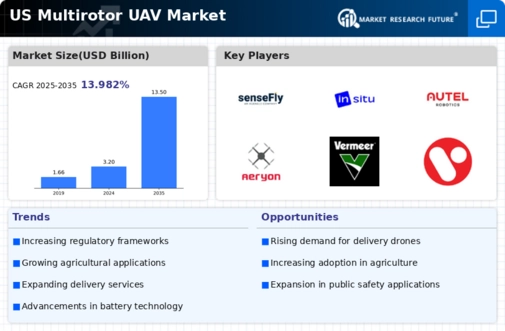Integration of AI and Automation
The integration of artificial intelligence (AI) and automation technologies is transforming the multirotor uav market. AI algorithms enhance flight planning, obstacle detection, and data analysis, making UAVs more autonomous and efficient. This technological shift is particularly relevant in sectors like logistics and emergency response, where rapid decision-making is critical. The market for AI in UAVs is anticipated to grow at a CAGR of 25% over the next five years, reflecting the increasing reliance on intelligent systems. As AI capabilities improve, the multirotor uav market is likely to see a rise in sophisticated applications, further driving its expansion and adoption across various industries.
Advancements in Battery Technology
Battery technology advancements are playing a crucial role in the evolution of the multirotor uav market. Enhanced battery efficiency and energy density are enabling longer flight times and increased payload capacities, which are essential for commercial applications. For example, the introduction of lithium-sulfur batteries has the potential to increase energy density by up to 50% compared to traditional lithium-ion batteries. This improvement allows UAVs to operate for extended periods, making them more viable for tasks such as surveillance and delivery services. As battery technology continues to evolve, it is expected that the multirotor uav market will witness a significant uptick in adoption rates, particularly in sectors that demand prolonged operational capabilities.
Growing Demand for Aerial Data Collection
The multirotor uav market is experiencing a surge in demand for aerial data collection across various sectors, including agriculture, construction, and environmental monitoring. This trend is driven by the increasing need for precise and real-time data to enhance decision-making processes. For instance, the agricultural sector utilizes multirotor UAVs for crop monitoring and yield estimation, which can lead to improved productivity. The market for aerial data collection is projected to reach $1.5 billion by 2026, indicating a robust growth trajectory. As industries recognize the value of aerial insights, the multirotor uav market is likely to expand significantly, catering to diverse applications that require high-resolution imagery and analytics.
Rising Interest in Drone Delivery Services
The multirotor uav market is witnessing a notable increase in interest surrounding drone delivery services. Companies are exploring the potential of UAVs to streamline logistics and enhance last-mile delivery efficiency. With the growing demand for quick and reliable delivery solutions, the market for drone delivery is projected to reach $29 billion by 2030. This trend is fueled by advancements in UAV technology, regulatory support, and changing consumer expectations. As businesses invest in drone delivery systems, the multirotor uav market is expected to expand, offering innovative solutions that cater to the evolving needs of consumers and businesses alike.
Increased Investment in UAV Research and Development
Investment in research and development (R&D) within the multirotor uav market is on the rise, driven by the need for innovation and competitive advantage. Companies are allocating substantial resources to develop new technologies, improve existing UAV designs, and explore novel applications. This focus on R&D is likely to yield advancements in flight stability, payload capacity, and operational efficiency. According to industry estimates, R&D spending in the UAV sector is expected to grow by 15% annually, reflecting the commitment to enhancing UAV capabilities. As R&D efforts intensify, the multirotor uav market is poised for significant growth, fostering a culture of innovation that could redefine industry standards.
























Leave a Comment